Penny Ch 26- Fetal spine and Musculoskeletal system
1/59
There's no tags or description
Looks like no tags are added yet.
Name | Mastery | Learn | Test | Matching | Spaced |
|---|
No study sessions yet.
60 Terms
d. Spina bifida aperta with Arnold-Chiari II malformation
What diagnosis is evident in Figure 26-30?
a. Spina bifida occulta with Dandy-Walker syndrome
b. Spina bifida aperta with Arnold-Chiari I malformation
c. Spina bifida occulta with Arnold-Chiari I malformation
d. Spina bifida aperta with Arnold-Chiari II malformation
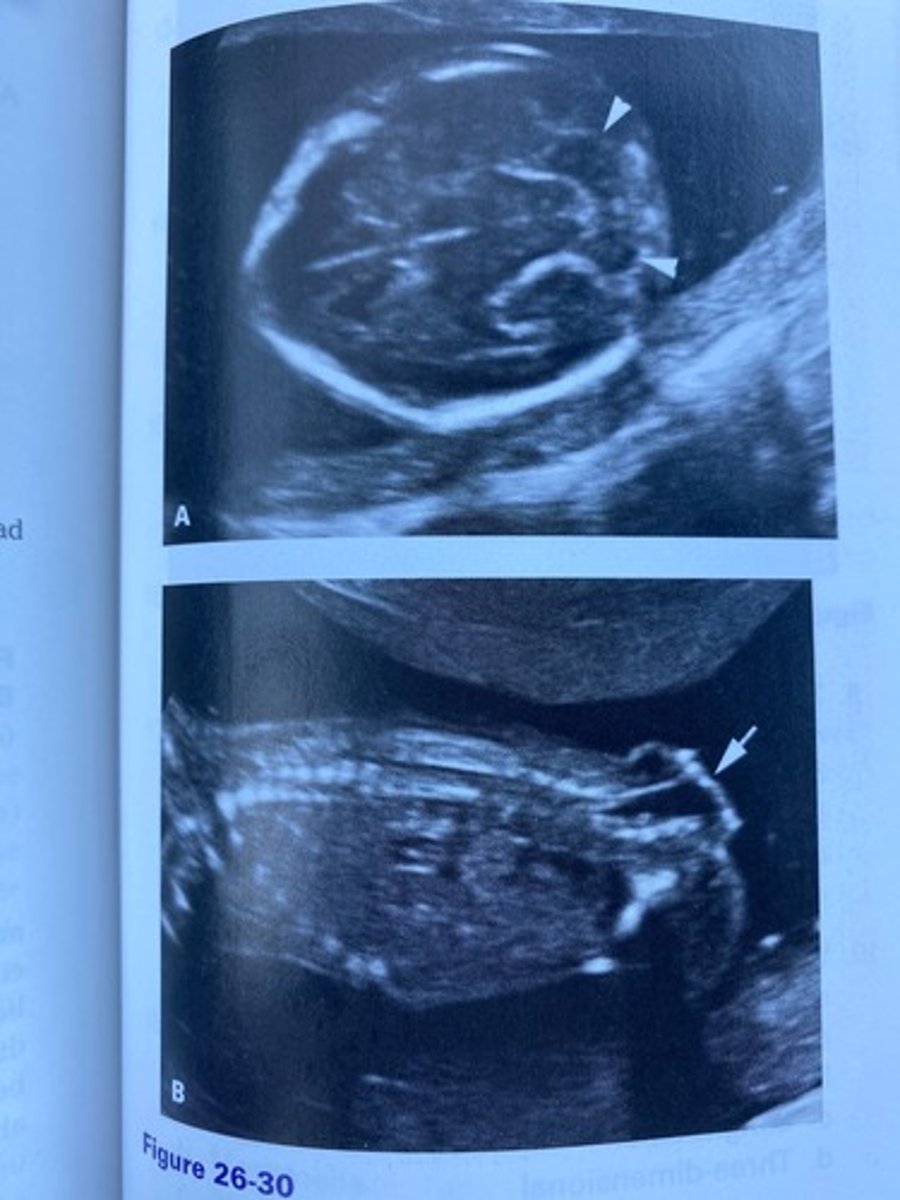
b. Open spinal defect
Which of the following is demonstrated by the large arrows in Figure 26-31?
a. Spina bifida occulta
b. Open spinal defect
c. Kyphosis
d. Kyphoscoliosis
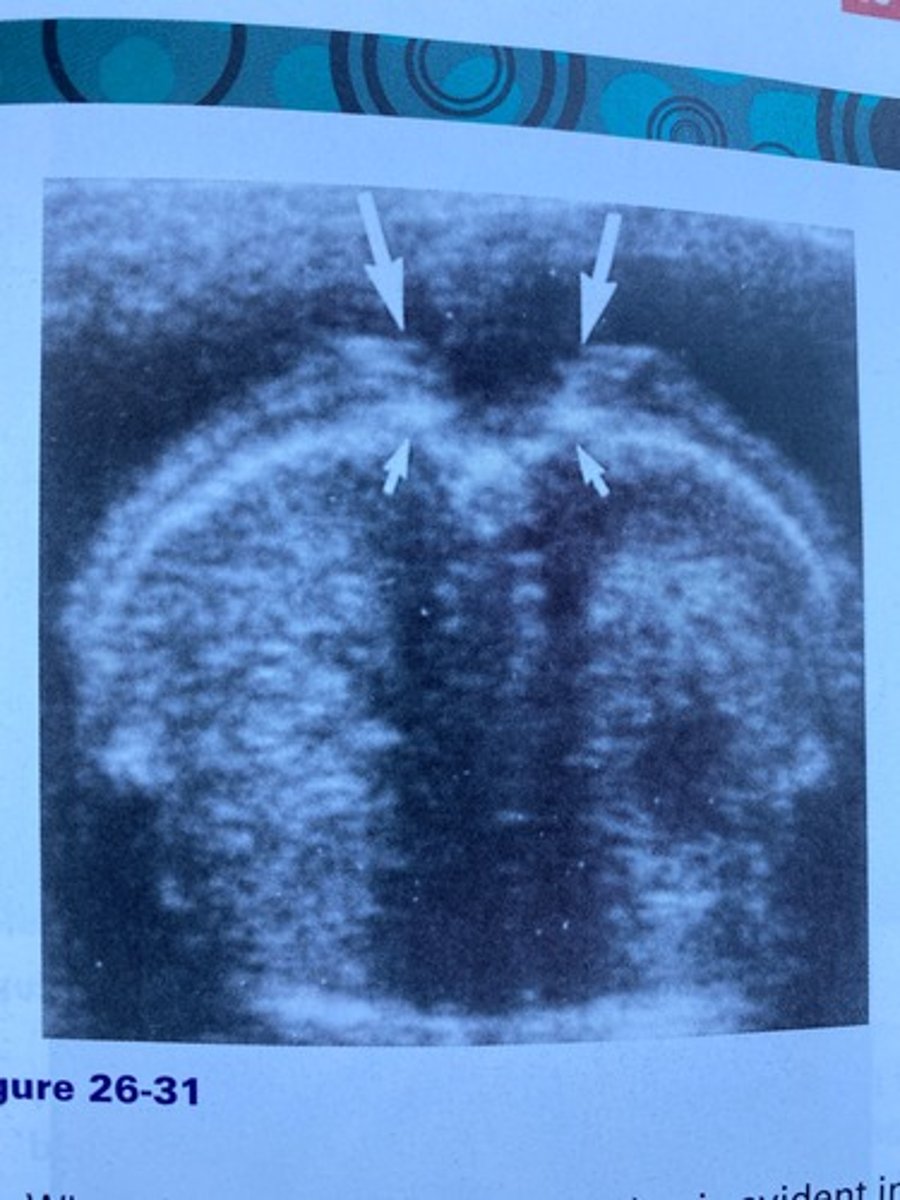
c. Enlarged cisterna magna
What cranial finding would be least likely associated with Figure 26-31?
a. Colpocephaly
b. Hydrocephalus
c. Enlarged cisterna magna
d. Flattened frontal bones

c. Clubfoot
What abnormality of the lower leg is evident in
Figure 26-32?
a. Amelia
b. Phocomelia
c. Clubfoot
d. Syndactyly
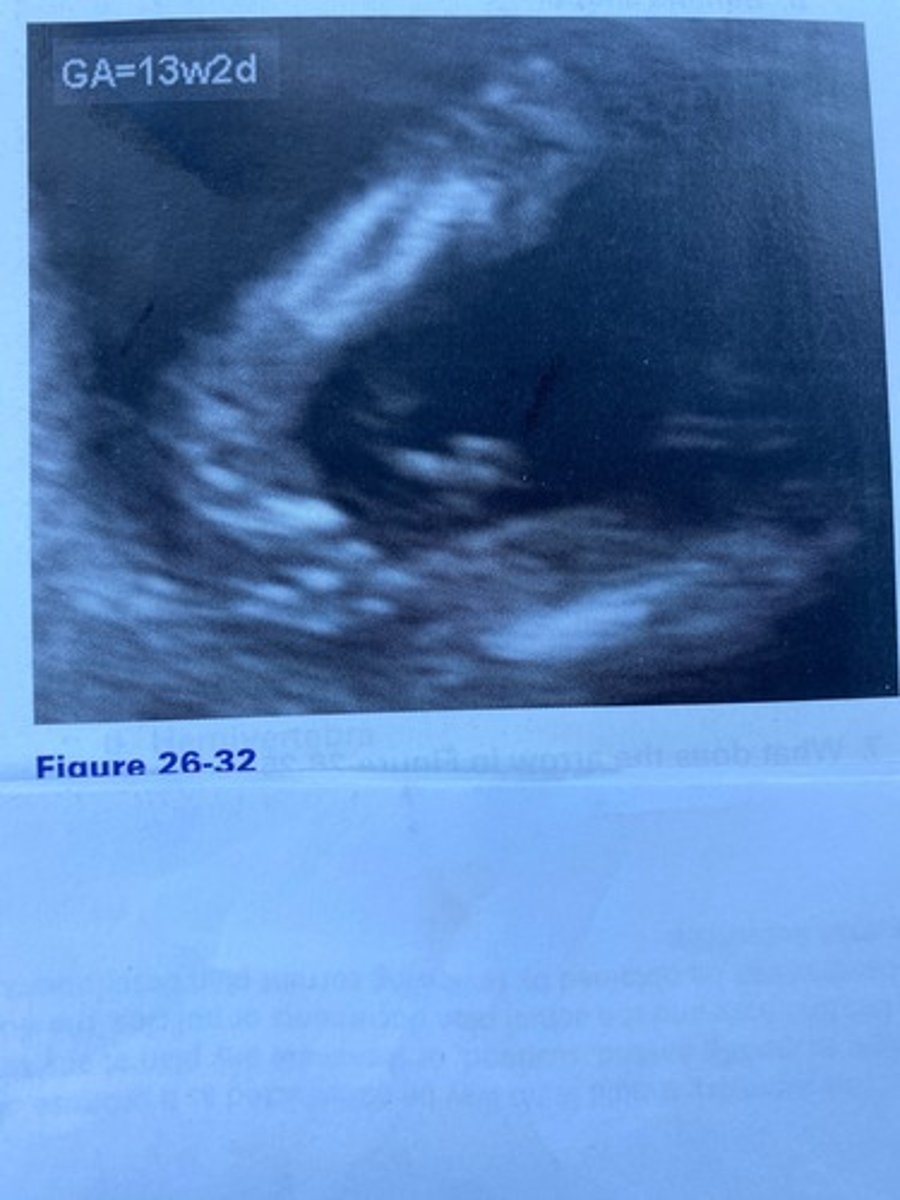
d. Scoliosis
What abnormality is evident in Figure 26-33?
a. Lordosis
b. Kyphosis
c. Hyphosis
d. Scoliosis
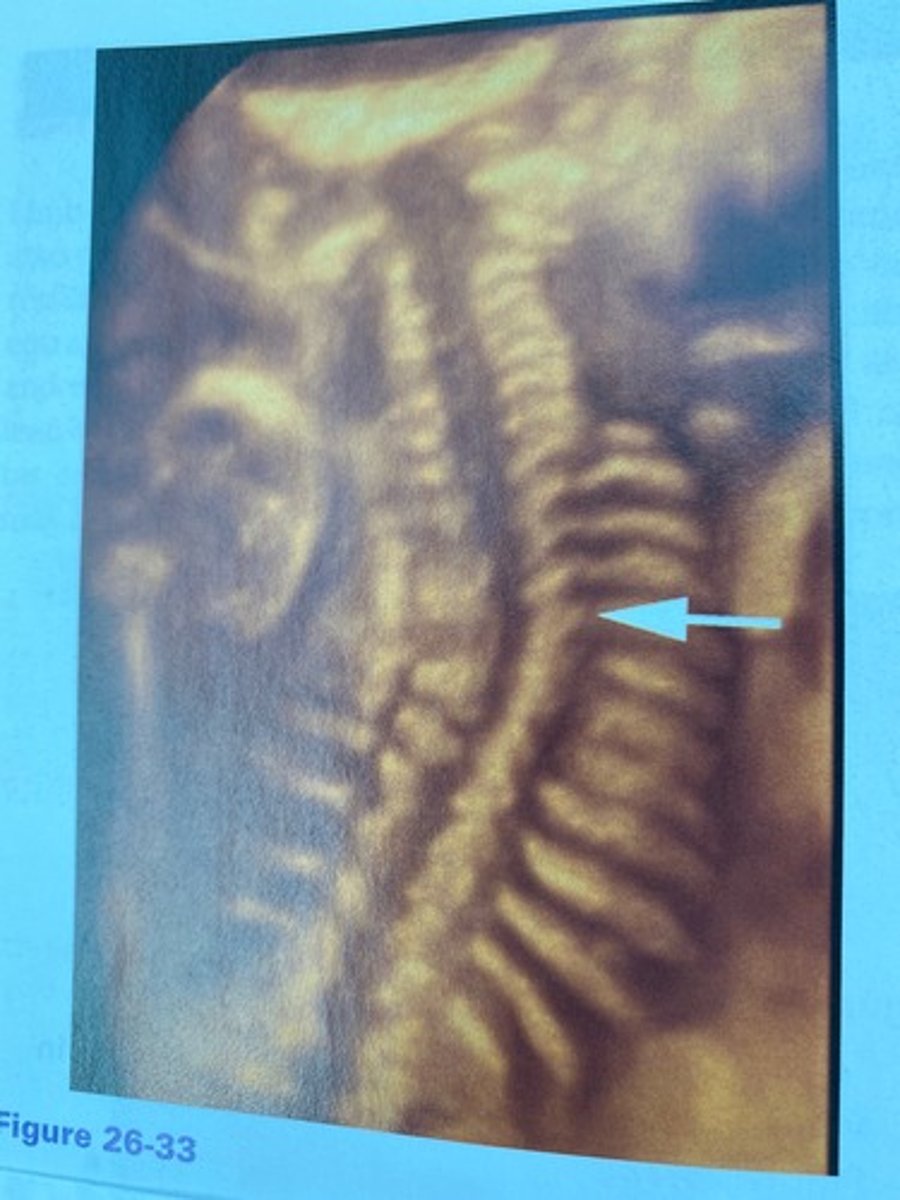
b. Banana shape
What finding of the fetal cerebellum would be associated with Figure 26-34?
a. Lemon shape
b. Banana shape
c. Absent
d. Enlarged
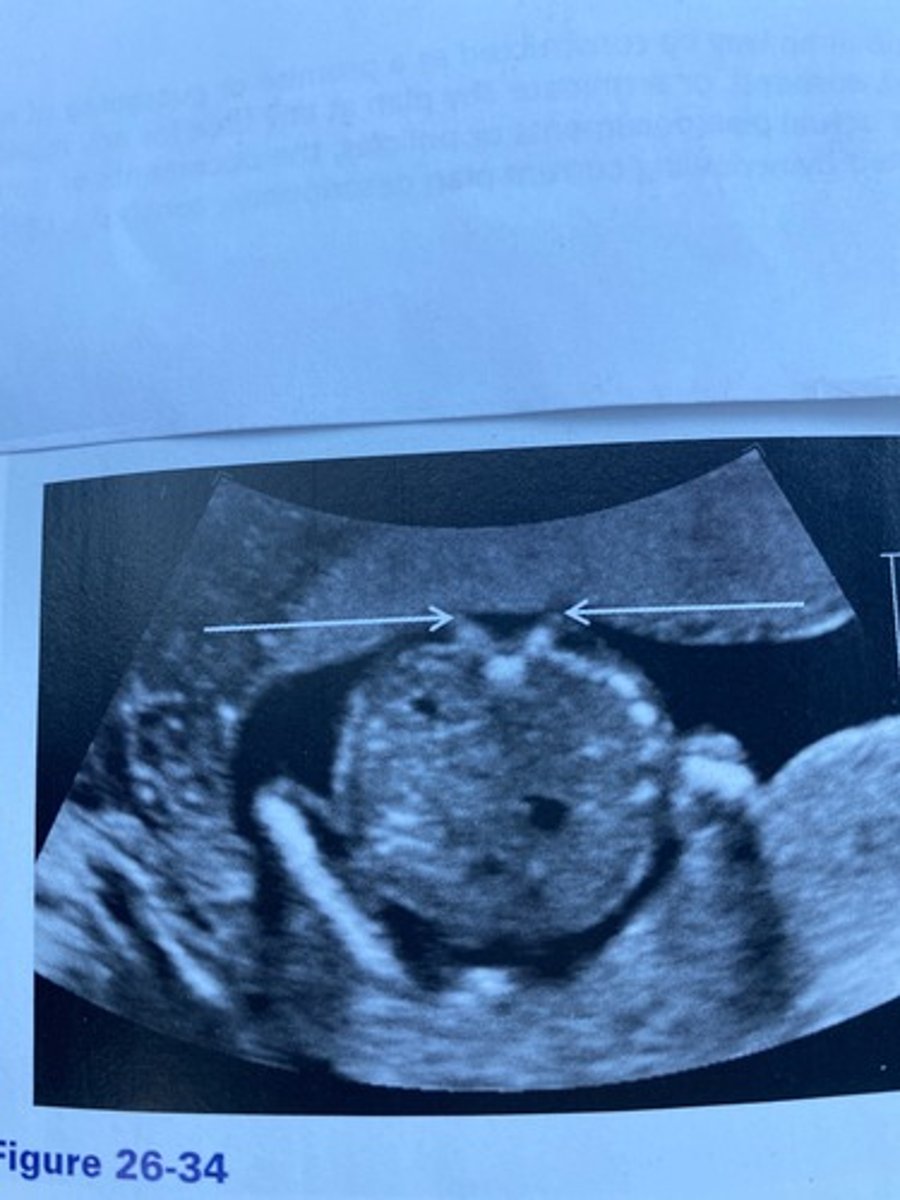
b. Thoracic spine
What does the arrow in Figure 26-35 indicate?
a. Cervical spine
b. Thoracic spine
c. Lumbar spine
d. Sacral spine
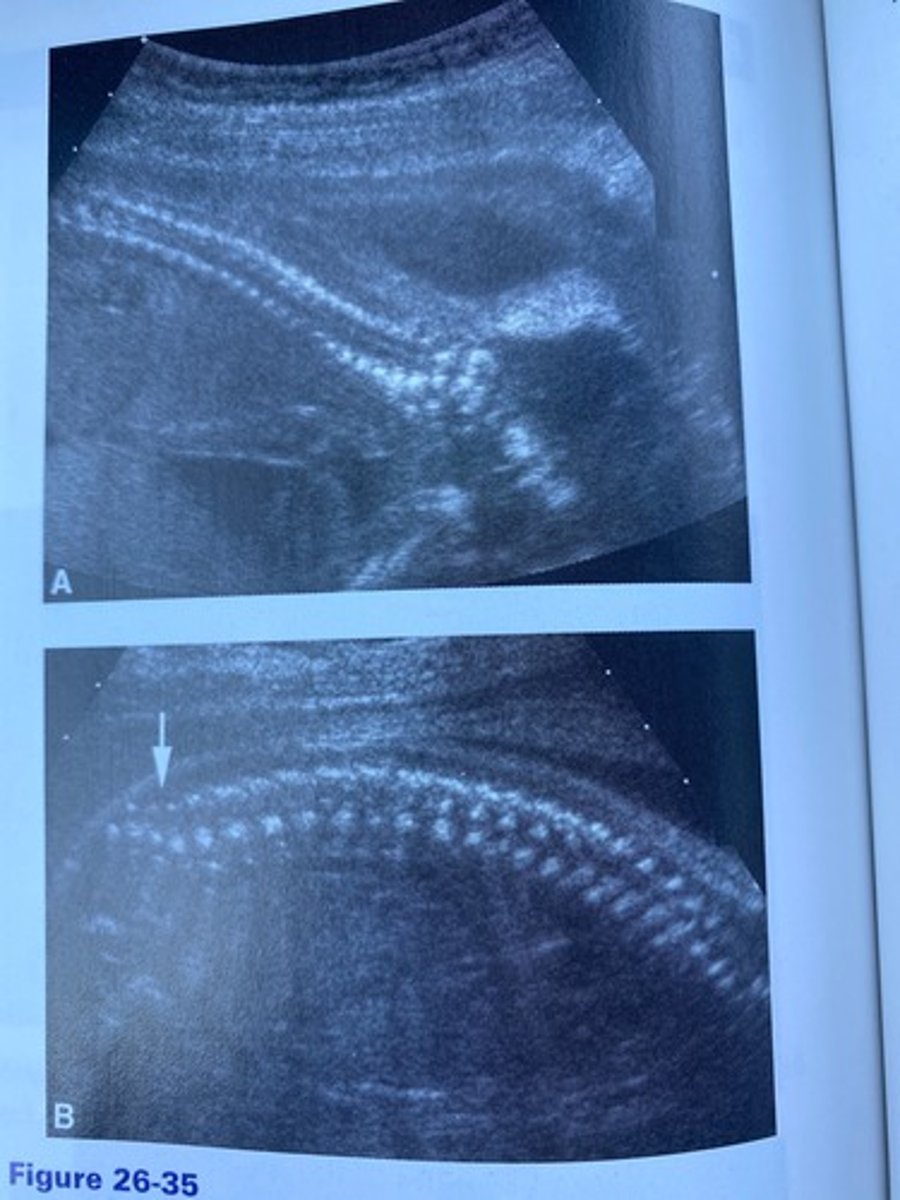
c. Longitudinal
What demonstration is Figure 26-35 of the spine?
a. Transverse
b. Coronal
c. Longitudinal
d. Three-dimensional
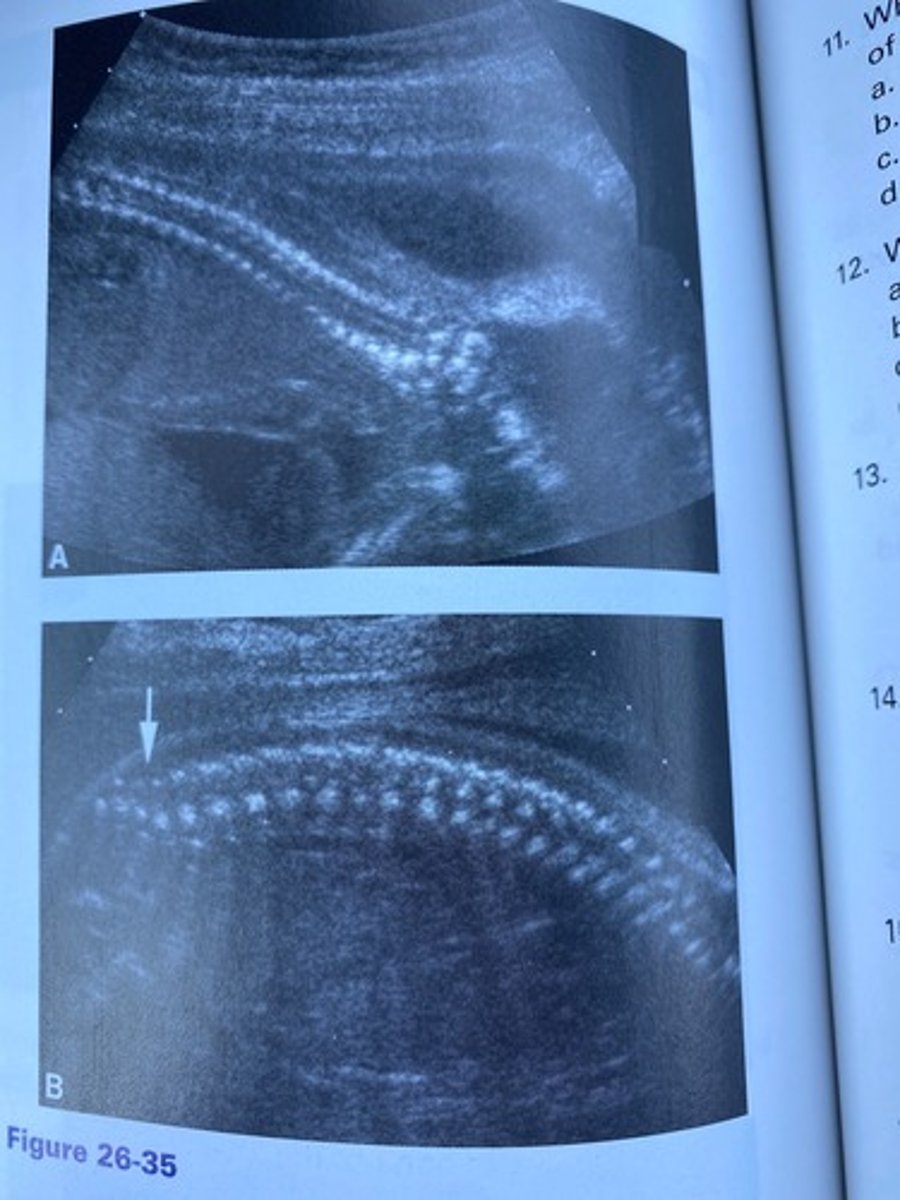
c. vertebral body.
The neural process of the spine will become all of the following except:
a. lamina.
b. pedicle.
c. vertebral body.
d. spinous process.
c. Longitudinal
What demonstration is Figure 26-36 of the fetal spine?
a. Transverse
b. Coronal
c. Longitudinal
d. Three-dimensional
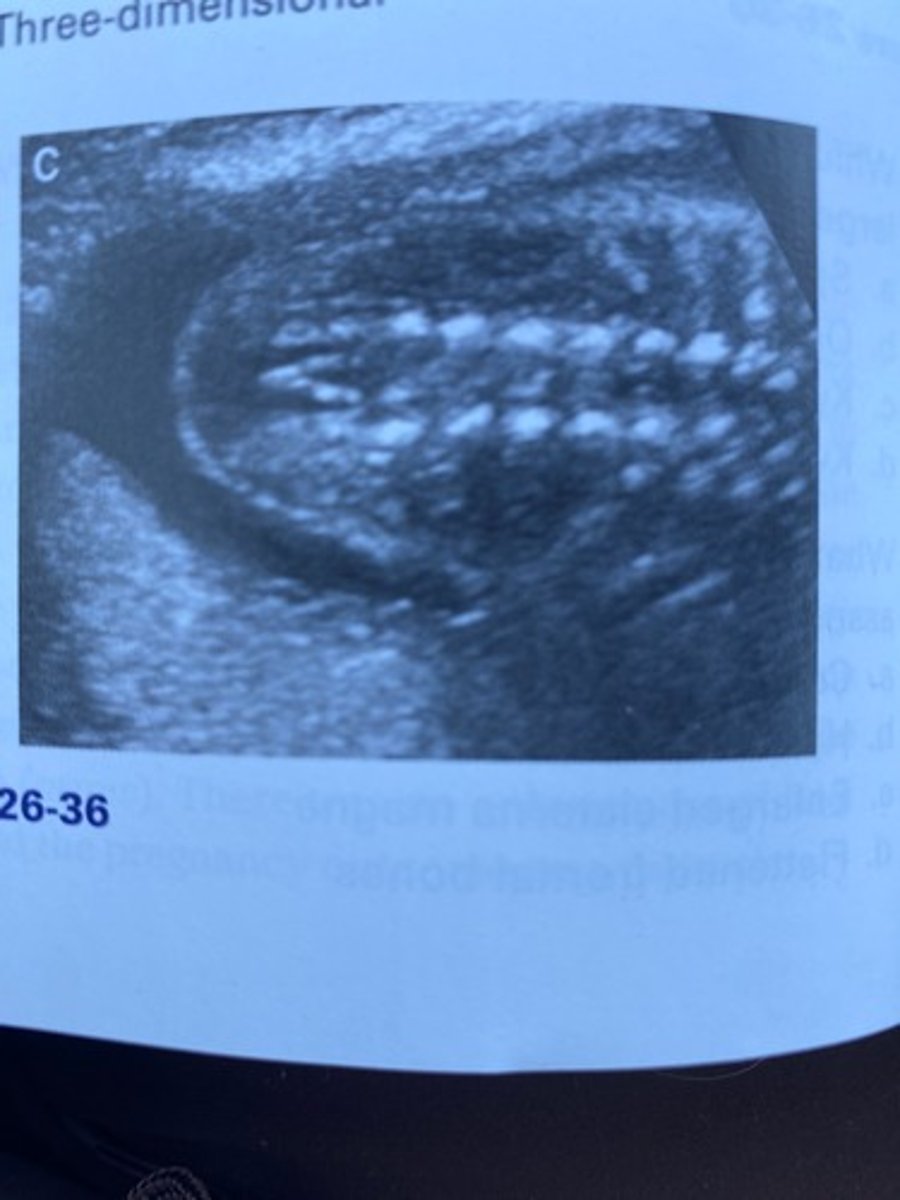
d. Hemimelia
What is the term defined as the absence of part of an extremity distal to the elbow or knee?
a. Phocomelia
b. Amelia
c. Acromelia
d. Hemimelia
c. Apodia
What is the term for absence of a foot?
a. Amelia
b. Acheiria
c. Apodia
d. Arthrogryposis
b. Talipomanus
What is the term for clubhand?
a. Sirenomelia
b. Talipomanus
c. Syndactyly
d. Rhizomelia
a. hand.
Acheiria is absence of the:
a. hand.
b. foot.
c. elbow.
d. knee.
b. Lateral
The radius is located on what side of the forearm?
a. Medial
b. Lateral
a. Tibia
What is the larger bone of the lower leg?
a. Tibia
b. Fibula
a. Rocker-bottom foot
Sonographically, you note that the fetal foot has a curved shape of the sole. What is the most likely diagnosis?
a. Rocker-bottom foot
b. Sirenomelia
c. Micromelia
d. Amelia
c. Rhizomelia
Which condition is often associated with heterozygous achondroplasia?
a. Oligodactyly
b. Mesomelia
c. Rhizomelia
d. Phocomelia
a. meninges.
The brain and spinal cord are covered by the:
a. meninges.
b. ependyma.
c. neural tube.
d. myelocele.
b. Frontal bossing
The fetus in Figure 26-37 is suffering from achondroplasia. What is noted in this profile image?
a. Ventriculomegaly
b. Frontal bossing
c. Lemon sign
d. Cebocephaly
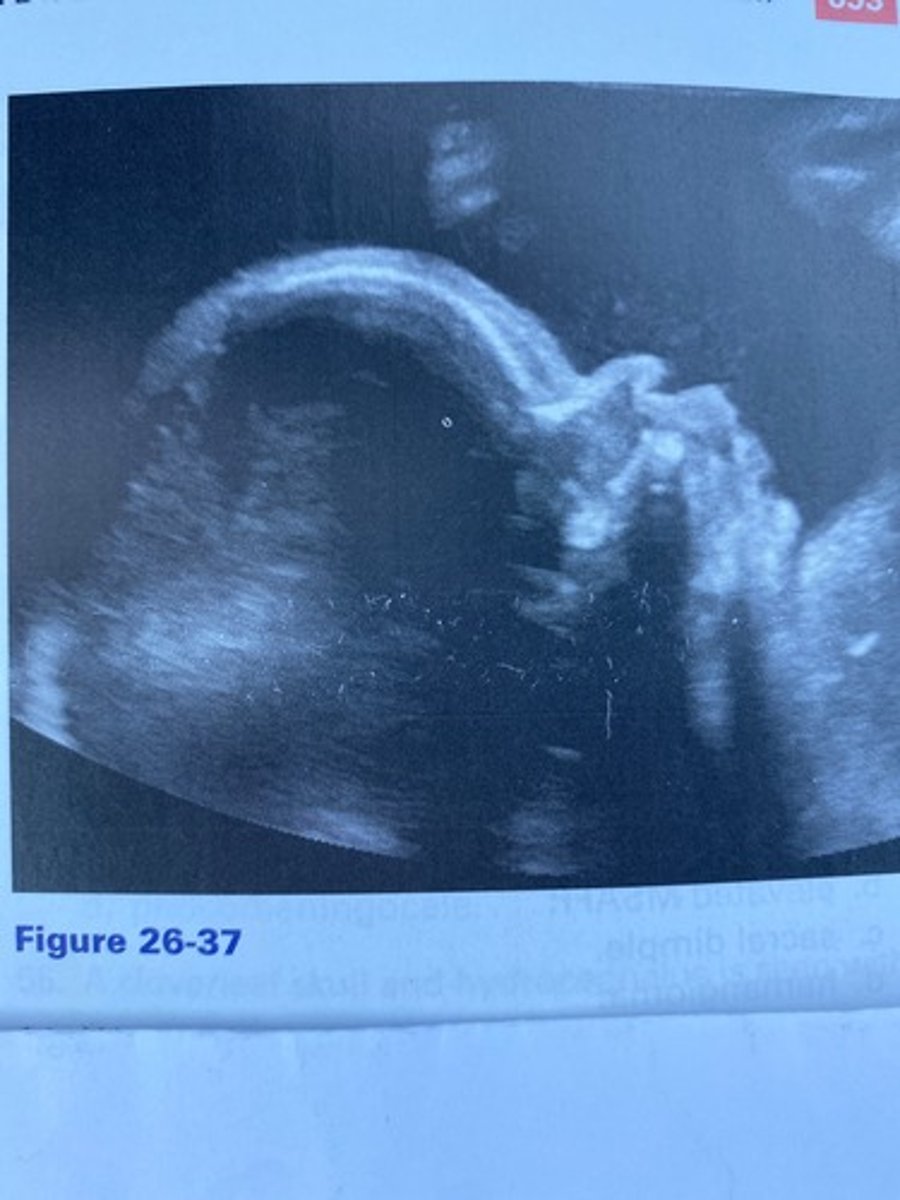
c. Folate
What is the maternal dietary supplement that has been shown to significantly reduce the likelihood of the fetus suffering from a neural tube defect?
a. AFP
b. Estriol
c. Folate
d. Pregnancy protein A
a. clubfoot.
Talipes equinovarus is associated with:
a. clubfoot.
b. syndactyly.
c. rhizomelia.
d. rocker-bottom feet.
a. acoustic shadowing.
The artifact seen posterior to solid structures such as fetal bone is referred to as:
a. acoustic shadowing.
b. posterior enhancement.
c. reverberation artifact.
d. edge artifact.
d. Hemivertebra
What is the anomaly of the spine in which there is absence of all or part of a vertebral body and posterior element?
a. Kyphosis
b. Scoliosis
c. Kyphoscoliosis
d. Hemivertebra
d. amniotic band syndrome.
The disorder associated with fetal amputations is:
a. achondroplasia.
b. osteogenesis imperfecta.
c. thanatophoric dysplasia.
d. amniotic band syndrome.
b. autosomal dominant.
The form of inheritance in which at least one parent has to be a carrier of an abnormal gene for it to be passed to the fetus is:
a. autosomal recessive.
b. autosomal dominant.
c. inherited dominant.
d. inherited recessive.
b. caudal regression syndrome.
The condition associated with the absence of the
sacrum and соссух:
a. limb-body wall complex.
b. caudal regression syndrome.
c. thanatophoric dwarfism.
d. heterozygous achondroplasia.
b. elevated MSAFP.
All of the following are characteristics of spina bifida occulta except:
a. closed defect.
b. elevated MSAFP.
c. sacral dimple.
d. hemangioma.
c. colpocephaly.
The abnormal lateral ventricle shape in which there is a small frontal horn and enlarged occipital horn is referred to as:
a. cebocephaly.
b. banana sign.
c. colpocephaly.
d. cephalocele.
d. normal MSAFP
All of the following are characteristics of spina bifida cystica except:
a. banana sign.
b. lemon sign.
c. enlarged massa intermedia.
d. normal MSAFP
d. cardiac.
In VACTERL association, the letter "C" stands for
a. cerebellar.
b. C-spine.
c. cranial.
d. cardiac.
b. enlarged posterior fossa.
All of the following are associated with spina bifida except:
a. splaying of the laminae.
b. enlarged posterior fossa.
c. lemon sign.
d. banana sign.
b. scoliosis.
The abnormal lateral curvature of the spine is referred to as:
a. kyphosis.
b. scoliosis.
c. splaying.
d. achondroplasia.
a. an abnormal shape of the fetal skull.
The lemon sign denotes:
a. an abnormal shape of the fetal skull.
b. a normal shape of the cerebellum.
c. an abnormal shape of the cerebellum.
d. a normal shape of the fetal skull.
b. decreased MSAFP.
All of the following are clinical or sonographic findings consistent with LBWC except:
a. ventral wall defects.
b. decreased MSAFP.
c. marked scoliosis.
d. shortened umbilical cord.
b. achondroplasia.
A disorder that results in abnormal bone growth and dwarfism is:
a. osteogenesis imperfecta.
b. achondroplasia.
c. radial ray defect.
d. caudal regression syndrome.
b. Preexisting maternal diabetes
Which of the following would increase the likelihood of a fetus developing sirenomelia and caudal regression syndrome?
a. Previous cesarean section
b. Preexisting maternal diabetes
c. Previous ectopic pregnancy
d. Elevated hG
c. Arnold-Chiari Il malformation.
The group of fetal head and brain abnormalities that often coexists with spina bifida is referred to as:
a. Dandy-Walker malformation.
b. Budd-Chiari syndrome.
c. Arnold-Chiari Il malformation.
d. amniotic band syndrome.
a. limb.
In VACTERL association, the letter "L' stands for:
a. limb.
b. lung.
c. liver.
d. larynx.
b. achondroplasia.
The most common nonlethal skeletal dysplasia is:
a. achondrogenesis.
b. achondroplasia.
c. thanatophoric dysplasia.
d. osteogenesis imperfecta.
d. absent mineralization of the skull.
Achondroplasia is associated with all of the following except:
a. frontal bossing.
b. flattened nasal bridge.
c. trident hand.
d. absent mineralization of the skull.
d. Arthrogryposis
What abnormality results in limitation of the fetal limbs as a result of joint contractures?
a. Acromegaly
b. Radial ray defect
c. Achondrogenesis
d. Arthrogryposis
d. massa intermedia.
The thalamic tissue located within the third ventricle of the brain that can become enlarged with Arnold-Chiari II malformation is the:
a. corpus callosum.
b. cerebellar vermis.
c. cavum septum pellucidum.
d. massa intermedia.
c. shortening of the proximal segment of a limb.
Rhizomelia denotes:
a. long upper extremities.
b. shortening of an entire limb.
c. shortening of the proximal segment of a limb.
d. shortening of the distal segment of a limb.
b. caudal regression syndrome.
An absent sacrum and coccyx is referred to as:
a. sirenomelia.
b. caudal regression syndrome.
c. achondroplasia.
d. radial ray defect.
c. phocomelia.
Absent long bones with the hands and feet arising from the shoulders and hips describes:
a. micromelia.
b. mesomelia.
c. phocomelia.
d. arthrogryposis.
c. multiple dislocated joints.
All of the following are characteristic sonographic findings of achondrogenesis except:
a. micromelia.
b. absent mineralization of the pelvis.
c. multiple dislocated joints.
d. polyhydramnios.
d. osteogenesis imperfecta.
Upon sonographic interrogation of a 28-week pregnancy, you note that when pressure is applied to the fetal skull, the skull can be easily distorted. This is sonographic evidence of
a. Arnold-Chiari Il malformation.
b. achondroplasia.
c. thanatophoric dysplasia.
d. osteogenesis imperfecta.
d. osteogenesis imperfecta.
A bell-shaped chest and multiple fetal fractures are indicative of:
a. thanatophoric dysplasia.
b. caudal regression syndrome.
c. achondrogenesis.
d. osteogenesis imperfecta.
a. S-shaped spine.
All of the following are signs of Arnold-Chiari Il malformation except:
a. S-shaped spine.
b. banana sign.
c. lemon sign.
d. colpocephaly.
d. synechiae.
All of the following are associated with amniotic band syndrome except:
a. amputation of fetal parts.
b. anencephaly.
c. facial clefting.
d. synechiae.
b. sandal gap.
The exaggerated distance between the first toe and the second toe is:
a. trident toes.
b. sandal gap.
c. phocomelia.
d. mesomelia
c. mermaid syndrome.
Sirenomelia is commonly referred to as:
a. radial ray defect.
b. rhizomelia.
c. mermaid syndrome.
d. rocker-bottom feet.
c. radial ray defect.
Absence of the radius is referred to as:
a. talipes equinovarus.
b. clubfoot.
c. radial ray defect.
d. phocomelia.
d. phocomeningocele.
Sonographically, you visualize a mass extending from the distal spine of a fetus. This mass could be all of the following except:
a. SCT.
b. meningocele.
c. meningomyelocele.
d. phocomeningocele.
d. thanatophoric dysplasia.
A cloverleaf skull and hydrocephalus is seen with:
a. achondrogenesis.
b. osteogenesis imperfecta.
c. sirenomelia.
d. thanatophoric dysplasia.
c. Syndactyly
What term is defined as fusion of the digits?
a. Clinodactyly
b. Polydactyly
c. Syndactyly
d. Rhizodactyly
d. AFP.
A protein produced by the yolk sac and fetal liver that is found in excess in the maternal circulation in the presence of a neural tube defect is:
a. folate.
b. hCG.
c. Estriol.
d. AFP.
c. Sirenomelia
What condition is associated with bilateral renal agenesis, oligohydramnios, and fusion of the lower extremities?
a. SCT
b. Caudal displacement syndrome
c. Sirenomelia
d. Osteogenesis imperfect
a. The metatarsals and toes lie in the same plane as the tibia and fibula.
Which of the following is true for the diagnosis of clubfoot?
a. The metatarsals and toes lie in the same plane as the tibia and fibula.
b. The metatarsals are perpendicular to the tibia and fibula.
c. The carpals and metacarpals lie in the same plane as the tibia and fibula.
d. The tibia, fibula, and patella are perpendicular to the femur.